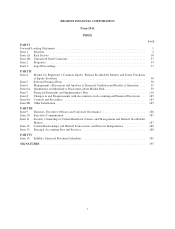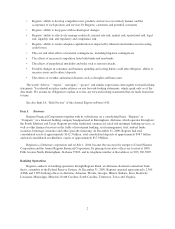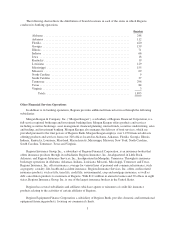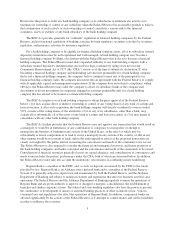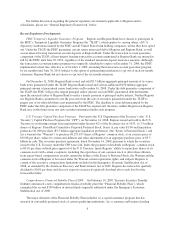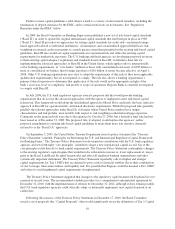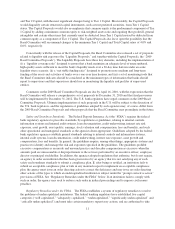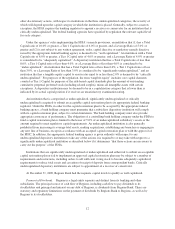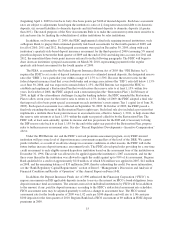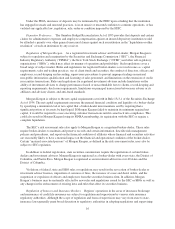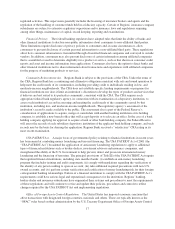Regions Bank 2009 Annual Report Download - page 23
Download and view the complete annual report
Please find page 23 of the 2009 Regions Bank annual report below. You can navigate through the pages in the report by either clicking on the pages listed below, or by using the keyword search tool below to find specific information within the annual report.items are assigned to broad risk categories, each with appropriate weights. The resulting capital ratios represent
capital as a percentage of total risk-weighted assets and off-balance sheet items.
The minimum guideline for the ratio of total capital (“Total Capital”) to risk-weighted assets (including
certain off-balance sheet items, such as standby letters of credit) is 8.0%. At least half of the Total Capital must
be “Tier 1 Capital,” which currently consists of qualifying common equity, qualifying noncumulative perpetual
preferred stock, including related surplus, and senior perpetual preferred stock issued to the U.S. Treasury under
the CPP, minority interests relating to qualifying common or noncumulative perpetual preferred stock issued by a
consolidated U.S. depository institution or foreign bank subsidiary, and certain “restricted core capital elements,”
as discussed below, less goodwill and certain other intangible assets. Currently, “Tier 2 Capital” may consist of,
among other things, qualifying subordinated debt, mandatorily convertible debt securities, other preferred stock
and trust preferred securities and a limited amount of the allowance for loan losses. Non-cumulative perpetual
preferred stock, trust preferred securities and other so-called “restricted core capital elements” are currently
limited to 25% of Tier 1 Capital. On January 28, 2010, the U.S. bank regulatory agencies announced a final rule
that, among other things, provides for an optional two-quarter delay, followed by an optional two-quarter
phase-in, of the application of the agencies’ regulatory limit on the inclusion of the allowance for loan and lease
losses in Tier 2 Capital for the portion of such allowances that is associated with the assets a banking
organization consolidates as a result of certain changes to GAAP.
The minimum guideline to be considered “well capitalized” for Tier 1 Capital and Total Capital is 6.0% and
10.0%, respectively. At December 31, 2009, Regions’ consolidated Tier 1 Capital ratio was 11.54% and its Total
Capital ratio was 15.78%. The elements currently comprising Tier 1 Capital and Tier 2 Capital and the minimum
Tier 1 Capital and Total Capital ratios may in the future be subject to change, as discussed in greater detail
below.
In addition, the Federal Reserve has established minimum leverage ratio guidelines to be considered “well
capitalized” for bank holding companies. These guidelines provide for a minimum ratio of Tier 1 Capital to
average total assets, less goodwill and certain other intangible assets (the “Leverage Ratio”), of 3.0% for bank
holding companies that meet certain specified criteria, including having the highest regulatory rating. All other
bank holding companies generally are required to maintain a Leverage Ratio of at least 4%. Regions’ Leverage
Ratio at December 31, 2009 was 8.90%.
In connection with the SCAP, banking regulators began supplementing their assessment of the capital
adequacy of a bank based on tangible common stockholders’ equity and a variation of Tier 1 Capital, known as
Tier 1 common equity. While not formally defined, analysts and banking regulators have assessed Regions’
capital adequacy using the tangible common stockholders’ equity and/or the Tier 1 common equity measure.
Because tangible common stockholders’ equity and Tier 1 common equity are not formally defined by GAAP or
formalized in the federal banking regulations, these measures are considered to be non-GAAP financial measures
and other entities may calculate them differently than Regions’ disclosed calculations (see the “GAAP to
Non-GAAP Reconciliation” section of Item 6. “Management’s Discussion and Analysis of Financial Condition
and Results of Operation” of this Annual Report on Form 10-K for further details).
The guidelines also provide that bank holding companies experiencing internal growth or making
acquisitions will be expected to maintain strong capital positions substantially above the minimum supervisory
levels without significant reliance on intangible assets. Furthermore, the Federal Reserve has indicated that it will
consider a “tangible Tier 1 Capital leverage ratio” (deducting all intangibles) and other indicators of capital
strength in evaluating proposals for expansion or new activities.
A subsidiary bank is subject to substantially similar risk-based and leverage capital requirements as those
applicable to Regions. Regions Bank was in compliance with applicable minimum capital requirements as of
December 31, 2009. Neither Regions nor Regions Bank has been advised by any federal banking agency of any
specific minimum capital ratio requirement applicable to it as of December 31, 2009.
9


